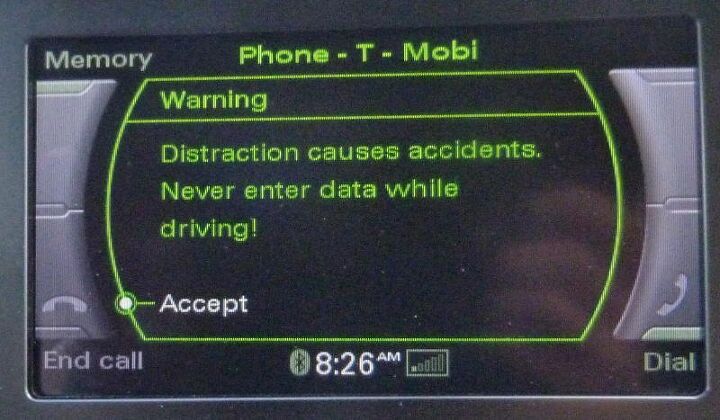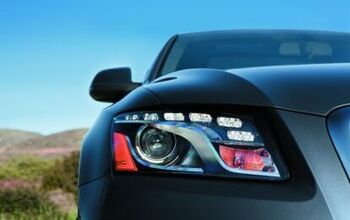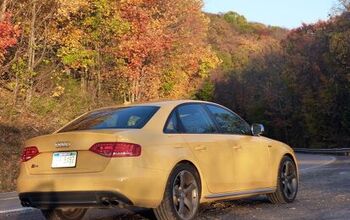Review: 2011 Audi Q5
Tick off all the boxes on an Audi Q5 order form, and you’ll find yourself staring at a $58,350 tab. Too much for a compact crossover? Well, the example seen here will set you back $20,000 less. Now I know what you’re thinking: “A mere $38,400 for a right-sized chunk of German engineering? Sign me up!” Not so fast—to save twenty large you must give up something. But what?
The Q5’s outer shell is very much current Audi…except it also strongly resembles the latest Cayenne. (And the latest VW Touareg for that matter. Time for a Fortune cover?) If these lines are viable for the far pricier Porsche—and dealers can’t keep the peppers on the lot—then certainly they’re sufficiently upscale for this Audi. One wrinkle: the full tab nets the twenty-inch five-spoke wheels the designers had in mind when they penned the Q5’s exterior. At the other end of the spectrum, you get the 18s seen here. Not bad rims, and certainly far from tiny by historical standards, but ensconced in a clean-to-a-fault soap bar with wheel openings sized for dubs they take the whole downmarket.
When optioned with the Luxury Package, the Q5 contends with the Infiniti EX35 for the segment’s best interior, with soft leather covering not only the seats but also the door armrests and the hood over the instruments. But with this package the price jumps well into the fifties—it’s only available with the V6 and top trim level. The base interior, though it shares the same Teutonically tasteful design and solid construction, is a decidedly less opulent place. The door armrests are molded soft-touch plastic with hard plastic door pulls, and the seat upholstery, though technically leather, like much automotive cowhide easily passes for vinyl. (In fact, I have in my notes that “the vinyl isn’t as convincing as some.”) All-black with a smattering of wood trim not your thing? Any of the three two-toned color schemes, offered at no additional cost, warms the cabin up considerably. But even then the interior doesn’t have the cozy, custom-tailored ambiance you’ll find inside the Infiniti (assuming you can fit). My wife loved that Infiniti. She was not a fan of the Audi, to put it politely.
Keeping the price under forty means the standard audio system (pretty good, but no 505-watt 14-speaker Bang & Olufsen, that’s another $850) and no nav. The latter omission isn’t a problem for me personally, except it also means that the primary “MMI” (climate, audio, etc.) control knob and its surrounding buttons are on the center stack, where they’re not nearly as comfortable to reach or as easy to operate. With the nav these controls are much more ergonomically located aft of the shifter on the console. My wife’s comment on the controls: “Every time I had to do something new I had to sit there and think about it.” Even starting the Q5 poses a challenge for the unfamiliar. I was baffled for a number of minutes (I don’t want to admit how many) until I noticed a slot tucked up next to the center stack’s air vents. Stick the entire fob into it, push till it goes click, and—what do you know—the car starts. Want to keep the fob in your pocket? Then spring for the V6.
In general, automotive infotainment systems won’t let you do various things while driving. Click over to the Q5’s phone dialer, and you’re informed: “Distraction causes accidents. Never enter data while driving.” Click to accept this…and the next page lets you enter a phone number. Better than not being able to do this at all, but making habitual liars out of drivers one click at a time.
You get the same firm but supportive seats regardless of how the Q5 is optioned. If you want to feel like you’re sitting on a sofa, an Audi is not the car for you. The high, unobstructed view forward from the driver’s seat is a key reason people buy this sort of vehicle instead of the wagon (“avant” for those who speak Audi) most driving enthusiasts would favor. Huge mirrors do the same for the rearward view. The Q5 is only 182 inches long, about the same as a BMW X3 or Infiniti EX35 but much less lengthy than a Cadillac SRX or Lexus RX 350, which really compete with the others in terms of price rather than size. Still, unlike in the Infiniti there’s plenty of room in back for the average adult. A high-mounted cushion provides good thigh support and the seatback reclines. The compact exterior has a larger impact on cargo space, but there’s still more of it than in the Infiniti. More of a bother: the artfully shaped tailgate affords no good grips and opens so high that women of below-average height will need a step ladder to reach it. Or get one of the upper-level trims, which include a power tailgate.
The stopwatch will tell you that the 2.0T’s 211-horsepower turbocharged four-cylinder engine is nearly as quick as the 3.2’s 270-horsepower V6, thanks to a plumper midrange (peak torque of 258 foot-pounds at 1,500 rpm vs. 243 at 3,000) and two extra cogs in the autobox (for a total of eight). But the six feels smoother and sounds far sweeter. The turbo four is more than capable of moving the Q5, but the six is much more likely to move the driver. With eight speeds, manually downshifting to second or third for a turn requires a lot of taps. The solution: shunt the shifter into S and the transmission will find a suitably low gear (or an even lower one) on its own.
The advantage of the turbo four + eight-speed combo: fuel economy. The EPA ratings of 20 city, 27 highway are tops for the premium compact crossover class, though BMW’s mighty turbocharged six is close behind. In casual suburban driving the (possibly optimistic) trip computer reported high twenties and low thirties.
Last winter I attended a comparison drive for the new BMW X3…and came away impressed with the Q5. The BMW had a steadier, more composed ride and more balanced handling, and when fitted with a (conservatively rated) 300-horsepower turbocharged six is much quicker. By any objective measure it’s the best performer in the segment. But the Audi’s chassis felt livelier and somehow more natural, and on curvy roads I enjoyed driving it more. The biggest difference: steering that clearly communicated what was going on at the front contact patches. This was the standard steering and suspension: a $2,950 “Audi Drive Select Page” offered only on the top trim substitutes active steering and adaptive shocks, but unlike on some other Audis doesn’t include an active rear differential. With the moderately rear-biased all-wheel-drive system and conventional rear differential a heavy right foot can coax the rear end to step out, but this is a more practical possibility with the BMW.
I wasn’t quite as impressed with the Q5’s steering this time around. Part of the reason could be that I didn’t have the other vehicles (X3, RX, SRX) on hand for a direct comparison. But the Q5’s steering also isn’t as exemplary during daily driving as it is when hustling along a curvy road. When driven casually, steering effort varies dramatically and somewhat unpredictably, and the feel is more artificial. The positive spin: when you most need the steering to talk, it talks. The Audi wants to be driven hard. Ignore its needs, and (like the high-strung, high-maintenance mistress I don’t have) it misbehaves while refusing to talk to you.
One mystery: the tested vehicle was fitted with W-rated Goodyear Excellence tires. Such “grand touring summer” tires, though commonly fitted as standard equipment in Europe, rarely appear in the all-season-loving U.S. On the Q5, we get performance-oriented rubber only with the “S Line” package, which is only offered with the V6. By accident or otherwise, the press fleet Q5 2.0T was wearing relatively sticky Euro-market treads.
So, to get to a $38,400 sticker (up $400 from the tested 2011 model), you’ve given up the wheels the designers intended, leather that feels like leather, ergonomic controls, a broad array of conveniences, the sweet sounding six, the trick shocks, and sticky tires. But do other cars offer more at this price point?
Not the related A4 Avant wagon, which lists for $800 more while including fewer features as standard equipment. You get a standard panoramic sunroof with the wagon—one’s an option on the Q5—but no power lumbar on the passenger seat, no wood trim, no three-zone automatic climate control, no automatic lights, no rain-sensing wipers, no trip computer. Tally up the differences using TrueDelta’s car price comparison tool, and the Q5’s price advantage widens to about $1,500. Detroit’s product strategy favored SUVs because they found car buyers were willing to pay more for them than for a wagon. The Germans didn’t get the memo. By this yardstick, the Q5 is a bargain: 380 pounds more car (4,090 total), less money.
The Infiniti EX35 that seduced my wife lists for $1,800 more, but includes a standard 3.5-liter V6. So is the Q5 3.2 a more appropriate comparison? Load up both the Infiniti and a Q5 3.2, and the Japanese crossover ends up about $5,500 less. The Germans charge top dollar for options, who knew?
A similarly-equipped BMW X3 xDrive2.8i lists for about $4,000 more, partly because you must specify the “Premium Package” to get the leather, wood trim, and dual four-way power lumbar adjustments standard on the Audi. This brings along some features not on the tested Audi, most notably a panoramic sunroof. Adjust for these, and the Audi retains a roughly $2,200 advantage. Enough to sway some buyers? Maybe. At a minimum the Audi is competitively priced.
So, with the Audi Q5 car buyers face a quandary. It’s fun to drive compared to any other compact crossover save the BMW, but anyone who makes this a top priority will (or at least should) go with the A4 Avant or BMW 3-Series wagon instead. So the Q5 is more likely to sell to those seeking the perceived superior comfort and convenience of a crossover. But a sub-forty Q5 lacks many comforts and conveniences. Check off the boxes to get these, and the price tag rapidly ascends into the mid-forties and beyond, at which point the Q5 isn’t as good a value.
Audi provided the vehicle, insurance and one tank of gas for this review.
Michael Karesh operates TrueDelta, an online source of automotive pricing and reliability data.
Michael Karesh lives in West Bloomfield, Michigan, with his wife and three children. In 2003 he received a Ph.D. from the University of Chicago. While in Chicago he worked at the National Opinion Research Center, a leader in the field of survey research. For his doctoral thesis, he spent a year-and-a-half inside an automaker studying how and how well it understood consumers when developing new products. While pursuing the degree he taught consumer behavior and product development at Oakland University. Since 1999, he has contributed auto reviews to Epinions, where he is currently one of two people in charge of the autos section. Since earning the degree he has continued to care for his children (school, gymnastics, tae-kwan-do...) and write reviews for Epinions and, more recently, The Truth About Cars while developing TrueDelta, a vehicle reliability and price comparison site.
More by Michael Karesh
Latest Car Reviews
Read moreLatest Product Reviews
Read moreRecent Comments
- CaddyDaddy Start with a good vehicle (avoid anything FCA / European and most GM, they are all Junk). Buy from a private party which allows you to know the former owner. Have the vehicle checked out by a reputable mechanic. Go into the situation with the upper hand of the trade in value of the car. Have the ability to pay on the spot or at you bank immediately with cash or ability to draw on a loan. Millions of cars are out there, the one you are looking at is not a limited commodity. Dealers are a government protected monopoly that only add an unnecessary cost to those too intellectually lazy to do research for a good used car.
- Redapple2 I gave up on Honda. My 09 Accord Vs my 03. The 09s- V 6 had a slight shudder when deactivating cylinders. And the 09 did not have the 03 's electro luminescent gages. And the 09 had the most uncomfortable seats. My brother bought his 3rd and last Honda CRV. Brutal seats after 25 minutes. NOW, We are forever Toyota, Lexus, Subaru people now despite HAVING ACCESS TO gm EMPLOYEE DISCOUNT. Despite having access to the gm employee discount. Man, that is a massive statement. Wow that s bad - Under no circumstances will I have that govna crap.
- Redapple2 Front tag obscured. Rear tag - clear and sharp. Huh?
- Redapple2 I can state what NOT to buy. HK. High theft. Insurance. Unrefined NVH. Rapidly degrading interiors. HK? No way !
- Luke42 Serious answer:Now that I DD an EV, buying an EV to replace my wife’s Honda Civic is in the queue. My wife likes her Honda, she likes Apple CarPlay, and she can’t stand Elon Musk - so Tesla starts the competition with two demerit-points and Honda starts the competition with one merit-point.The Honda Prologue looked like a great candidate until Honda announced that the partnership with GM was a one-off thing and that their future EVs would be designed in-house.Now I’m more inclined toward the Blazer EV, the vehicle on which the Prologue is based. The Blazer EV and the Ultium platform won’t be orphaned by GM any time soon. But then I have to convince my wife she would like it better than her Honda Civic, and that’s a heavy lift because she doesn’t have any reason to be dissatisfied with her current car (I take care of all of the ICE-hassles for her).Since my wife’s Honda Civic is holding up well, since she likes the car, and since I take care of most of the drawbacks of drawbacks of ICE ownership for her, there’s no urgency to replace this vehicle.Honestly, if a paid-off Honda Civic is my wife’s automotive hill to die on, that’s a pretty good place to be - even though I personally have to continue dealing the hassles and expenses of ICE ownership on her behalf.My plan is simply to wait-and-see what Honda does next. Maybe they’ll introduce the perfect EV for her one day, and I’ll just go buy it.














































Comments
Join the conversation
Michael. How do you compare Audi Q5 with Acura RDX?
I did copious amounts of research before deciding to buy a Q5 about 6 weeks ago. I never considered the GLK or the X3 for price/value differences as well as performance, in clouding economy. I'd been driving a Cayman S for over four years and decided to get something that would accommodate my wife and the dog. I bought the Q5 2.0T with the Premium+ package, so I got to the mid $40's in price ($45,100) after dealing a bit. About the only fault I've found is that the seat heaters are a little weak. Seems that after some complaint in '08, Audi turned them down a few notches. The 2.0T has more than adequate punch when needed and I've been getting 24 mpg in mixed, mostly suburban driving. Most folks consider me an aggressive driver having done autos and track events for the last 10 years. As noted in the review, fit & finish are superb (remember I'm coming from a $70k Porsche). In this group, it doesn't have the biggest load space but my golf clubs and cart fit without needing to fold the seats. I suppose the only question will be it's reliability and only time will tell on that count. X3s and GLKs abound in my area... they are everywhere. Q5s are relatively few and I like having something a little different from the crowd. With word today that we'll be seeing $4/gal. gas by Memorial Day, I couldn't be happier with this choice. Just for the record, this is the first SUV/wagon for me. I drove a Volvo 245S for over 10 years and have had an Isuzu Trooper, Grand Cherokee, ML 430, and a G500 in the past. The Q5 2.0T comes in as the best upscale sensible choice among the current offerings.